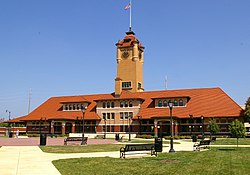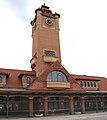
Chicago Union Station is an intercity and commuter rail terminal located in the West Loop neighborhood of the Near West Side of Chicago. Amtrak's flagship station in the Midwest, Union Station is the terminus of eight national long-distance routes and eight regional corridor routes. Six Metra commuter lines also terminate here.

The Lincoln Service is a 284-mile (457 km) higher-speed rail service operated by Amtrak that runs between Chicago, Illinois and St. Louis, Missouri. The train is a part of the Illinois Service and is partially funded by the Illinois Department of Transportation. The train uses the same route as the long-distance Texas Eagle, which continues to San Antonio and Los Angeles. A connection with the Kansas City-bound Missouri River Runner is available in St. Louis.

The Gulf, Mobile and Ohio was a Class I railroad in the central United States whose primary routes extended from Mobile, Alabama, and New Orleans, Louisiana, to St. Louis and Kansas City, Missouri, as well as Chicago, Illinois.

Central Station was an intercity passenger terminal in downtown Chicago, Illinois, at the southern end of Grant Park near Roosevelt Road and Michigan Avenue. Owned by the Illinois Central Railroad, it also served other companies via trackage rights. It opened in 1893, replacing Great Central Station, and closed in 1972 when Amtrak rerouted services to Union Station. The station building was demolished in 1974. It is now the site of a redevelopment called Central Station, Chicago.
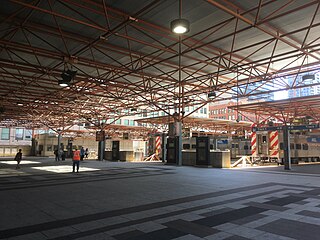
LaSalle Street Station is a commuter rail terminal at 414 South LaSalle Street in downtown Chicago. First used as a rail terminal in 1852, it was a major intercity rail terminal for the New York Central Railroad until 1968, and for the Chicago, Rock Island and Pacific Railroad until 1978, but now serves only Metra's Rock Island District. The present structure became the fifth station on the site when its predecessor was demolished in 1981 and replaced by the new station and the One Financial Place tower for the Chicago Stock Exchange. The Chicago Board of Trade Building, Willis Tower, and Harold Washington Library are nearby.

The Illinois Terminal Railroad Company, known as the Illinois Traction System until 1937, was a heavy duty interurban electric railroad with extensive passenger and freight business in central and southern Illinois from 1896 to 1956. When Depression era Illinois Traction was in financial distress and had to reorganize, the Illinois Terminal name was adopted to reflect the line's primary money making role as a freight interchange link to major steam railroads at its terminal ends, Peoria, Danville, and St. Louis. Interurban passenger service slowly was reduced, ending in 1956. Freight operation continued but was hobbled by tight street running in some towns requiring very sharp radius turns. In 1956, ITC was absorbed by a consortium of connecting railroads.

The Chicago and Western Indiana Railroad was the owner of Dearborn Station in Chicago and the trackage leading to it. It was owned equally by five of the railroads using it to reach the terminal, and kept those companies from needing their own lines into the city. With the closure of Dearborn Station in 1971 and the Calumet steel mills in 1985, the railroad was gradually downgraded until 1994 when it became a subsidiary of the Union Pacific Corporation.

The Alton Railroad was the final name of a railroad linking Chicago to Alton, Illinois; St. Louis, Missouri; and Kansas City, Missouri. Its predecessor, the Chicago and Alton Railroad, was purchased by the Baltimore and Ohio Railroad in 1931 and was controlled until 1942 when the Alton was released to the courts. On May 31, 1947, the Alton Railroad was merged into the Gulf, Mobile and Ohio Railroad. Jacob Bunn had been one of the founding reorganizers of the Chicago & Alton Railroad Company during the 1860s.

Springfield station is a brick railroad depot in Springfield, Illinois, the state capital. It is at mile 185 on Amtrak's Illinois and Missouri Route. As of 2007, it is served by five daily round trips each way: the daily Texas Eagle, and four daily Lincoln Service frequencies. It will be replaced by the Springfield-Sangamon Transportation Center, which is currently under construction, and expected to open in 2025.

Lincoln station is an Amtrak train station in Lincoln, Illinois, United States, at Broadway and Chicago Streets. Service is provided by Lincoln Service and the Texas Eagle. The current station is the rail line's former freight depot, renovated in 2017. Adjacent to the current station structure is a brick Spanish Mission-style depot building, constructed in 1911 by the former Chicago and Alton Railroad and later used by the Gulf, Mobile and Ohio Railroad. Although no longer used by Amtrak, the historic 1911 depot has been renovated for commercial use. During the 1980s and 1990s it served dually as a railroad station and restaurant.
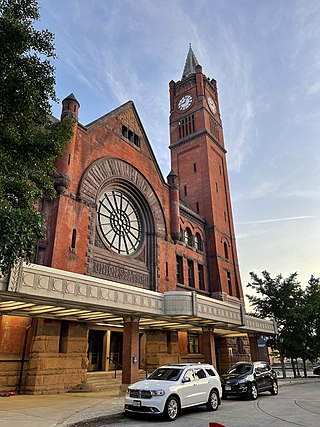
The Indianapolis Union Station is an intercity train station in the Wholesale District of Indianapolis, Indiana. Currently, Amtrak's Cardinal line serves the terminal, passing through Indianapolis three times a week.

The State House was a passenger train operated by Amtrak between Chicago, Illinois, and St. Louis, Missouri in the United States. This service began in 1973 and continued until 2006, when it was re-branded as the Lincoln Service as part of a three-fold service expansion over that route.

Uptown Station is an intermodal transportation center in Normal, Illinois, United States. It is served by Amtrak, the national railroad passenger system, and is the major intercity rail station in north-central Illinois. It appears on Amtrak timetables as Bloomington–Normal.
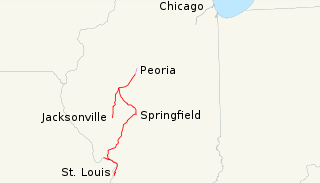
The Chicago, Peoria and St. Louis Railroad (CP&StL) was a railroad in the U.S. state of Illinois that operated a main line between Pekin and Madison via Springfield. Its property was sold at foreclosure to several new companies in the 1920s; the portion north of Springfield has since become the Illinois and Midland Railroad, while the remainder has been abandoned, except for a portion near St. Louis that is now owned by the Norfolk Southern Railway.

The Prairie Marksman was a daily passenger train operated by Amtrak between Chicago's Union Station and East Peoria, Illinois. The route was an indirect successor to the Rock Island's Peoria Rocket.

The Alton Limited was the Chicago & Alton Railway's (C&A) flagship service between Chicago, Illinois. and St. Louis, Missouri. It was introduced in 1899 and re-equipped in 1905 and 1924. The name and service were discontinued in late 1971.

Dayton Union Station was a railroad station serving Dayton, Ohio with daily passenger trains of several railroads. The station was located at 251 W. Sixth Street at the intersection of Ludlow Street, and it opened in 1900, replacing an earlier depot built in the mid-1850s. It was owned by the Dayton Union Railroad Co., which was owned by the Cincinnati, Hamilton and Dayton Railway, the Cleveland, Cincinnati, Chicago and St. Louis Railway, and the Pittsburgh, Cincinnati, Chicago and St. Louis Railroad. Through a series of mergers over the years, it was ultimately owned by the New York Central Railroad, Baltimore & Ohio Railroad, and Pennsylvania Railroad.

Peoria Union Station was a passenger rail hub for north-central Illinois, in Peoria, Illinois. Built in the Second Empire architecture style, it was located on Depot Street, between State and Oak Streets, near the Illinois River. At its peak, it had seven tracks operating. However, even by World War II, it was only a junction point for regional lines that seldom extended beyond the state of Illinois. This station, the Rock Island Depot and the Illinois Terminal reached their peak volume of trains in 1920 with 110 trains running in and out daily.
